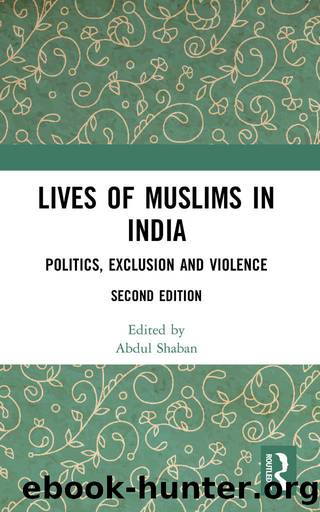Lives of Muslims in India by Abdul Shaban

Author:Abdul Shaban [Shaban, Abdul]
Language: eng
Format: epub
ISBN: 9780815392972
Publisher: Taylor and Francis
Published: 2018-01-10T08:00:00+00:00
The Impact of Islamist Political Ideology
The political Islamists aim to establish an Islamic state and enforce Islam as understood by one sect or another. They go significantly further than the moderates, who are content using symbols to mobilise Muslims. Islamists use the state to enforce compliance with Islamic cultural norms and desire to see Muslim society homogenised in the face of diversity of culture within Muslim society. They not only encourage Muslims to learn Urdu but also, without much success, discourage other languages. The idea is that Muslims should have not only a common religious identity but also a common culture. In this, they demonstrate similarities to right-wing Hindu parties, with emphasis on a common and homogenous culture and the blunting of local regional identities. The idea is that a culturally unified and homogenised Muslim community will be stronger and better equipped to fight the onslaught of Hindu extremism.
Maulana Abu Ala Maududi founded the Jamat-e-Islami (JI) in 1941. Maududi argued that it was the duty of every Muslim to fight to establish an Islamic state in India. Initially, JI opposed the demand for Pakistan even though its JI objective was to fight for an Islamic state within the country. As soon as Pakistan was created, Maududi moved to Pakistan and established the JI and a branch continued its activities on the Indian side of the border. In India, the JI laid low for some time after Independence and did not have much of a following, concentrating instead on building its cadre by training students. The Students Islamic Movement of India (SIMI) was its front organisation through which it reached out to the students and recruited its cadre. It emphasised character-building of young Muslims and provided ideological training to a select few.
During the 1980s, when there was a series of communal riots throughout India, and with militancy rising in Jammu and Kashmir, the stance of some SIMI leaders hardened, and they adopted violence as a means to achieve the objective of establishing a unified Muslim community. SIMI split when those opposing violence left the organisation and formed the Students Islamic Organisation. The rise in the level of violence against ordinary Muslims in society was a catalyst for the radicalisation of a section of the Muslim youth. SIMI, after its radicalisation in the post-Babri Masjid demolition period, existed only in few urban and semi-urban pockets with significant Muslim population. A few score educated youth were attracted to SIMI due to increasing structural and physical violence, discrimination, communal profiling by intelligence agencies and marginalisation of the community on the one hand and desire for revenge for targeting the community, indoctrination and Inter-Services Intelligence (ISI) support on the other hand. SIMI activists put provocative posters in Kanpur in March 2001 praying Allah to send one more Saladin â the crusader Sultan (to fight the present day enemies of Islam). The poster campaign was to protest the burning of Quran in Delhi on 9 March 2001. SIMI also organised a small march in Kanpur to protest burning of Quran.
Download
This site does not store any files on its server. We only index and link to content provided by other sites. Please contact the content providers to delete copyright contents if any and email us, we'll remove relevant links or contents immediately.
| Africa | Americas |
| Arctic & Antarctica | Asia |
| Australia & Oceania | Europe |
| Middle East | Russia |
| United States | World |
| Ancient Civilizations | Military |
| Historical Study & Educational Resources |
Machine Learning at Scale with H2O by Gregory Keys | David Whiting(4179)
Never by Ken Follett(3790)
Fairy Tale by Stephen King(3220)
The Man Who Died Twice by Richard Osman(2997)
Oathbringer (The Stormlight Archive, Book 3) by Brandon Sanderson(2877)
Will by Will Smith(2792)
Rationality by Steven Pinker(2291)
The Dark Hours by Michael Connelly(2243)
Can't Hurt Me: Master Your Mind and Defy the Odds - Clean Edition by David Goggins(2227)
The Dawn of Everything: A New History of Humanity by David Graeber & David Wengrow(2122)
Friends, Lovers, and the Big Terrible Thing by Matthew Perry(2119)
Principles for Dealing With the Changing World Order: Why Nations Succeed and Fail by Ray Dalio(1974)
HBR's 10 Must Reads 2022 by Harvard Business Review(1776)
A Short History of War by Jeremy Black(1762)
Go Tell the Bees That I Am Gone by Diana Gabaldon(1687)
515945210 by Unknown(1599)
A Game of Thrones (The Illustrated Edition) by George R. R. Martin(1589)
Kingdom of Ash by Maas Sarah J(1524)
443319537 by Unknown(1470)
